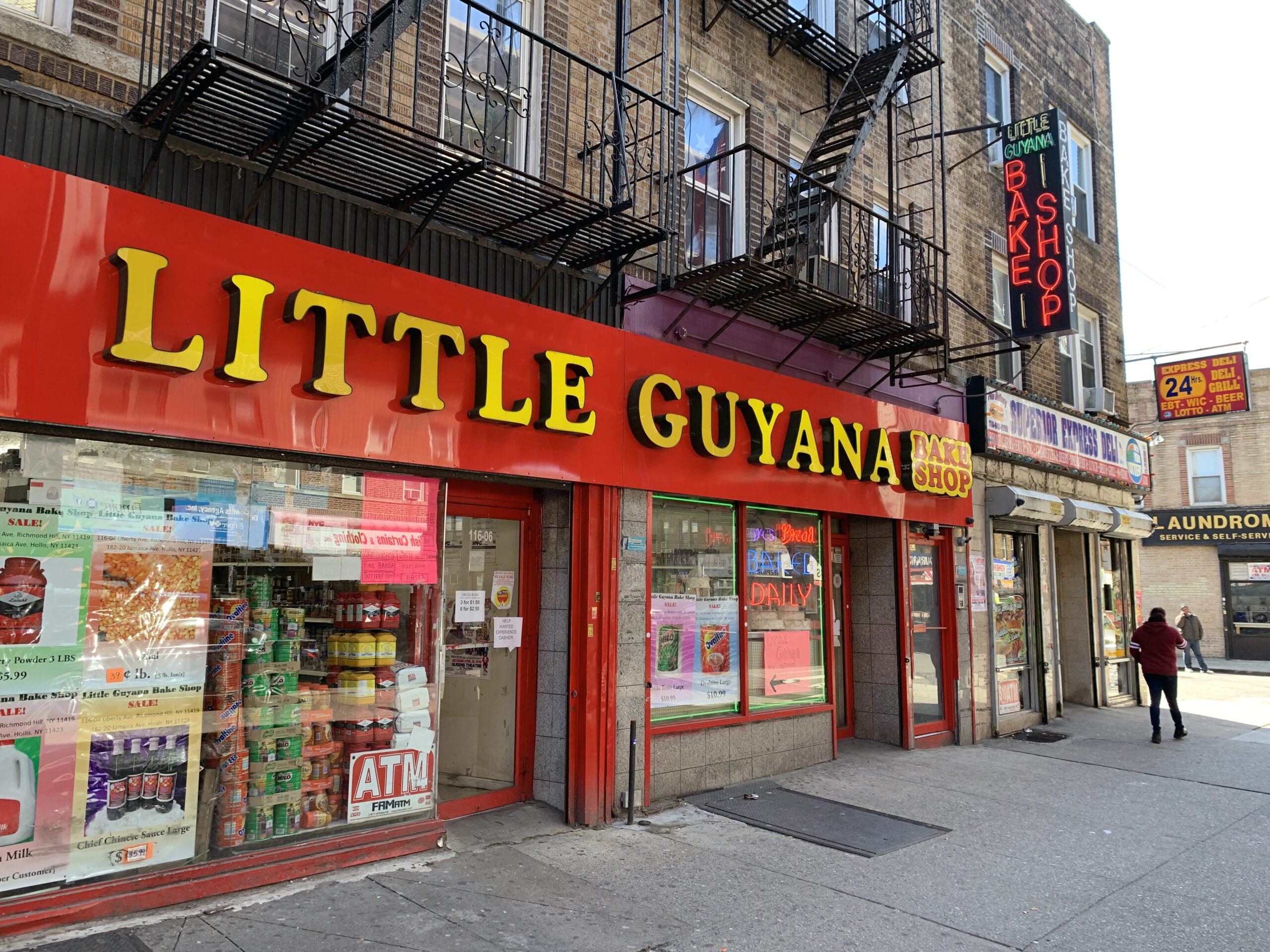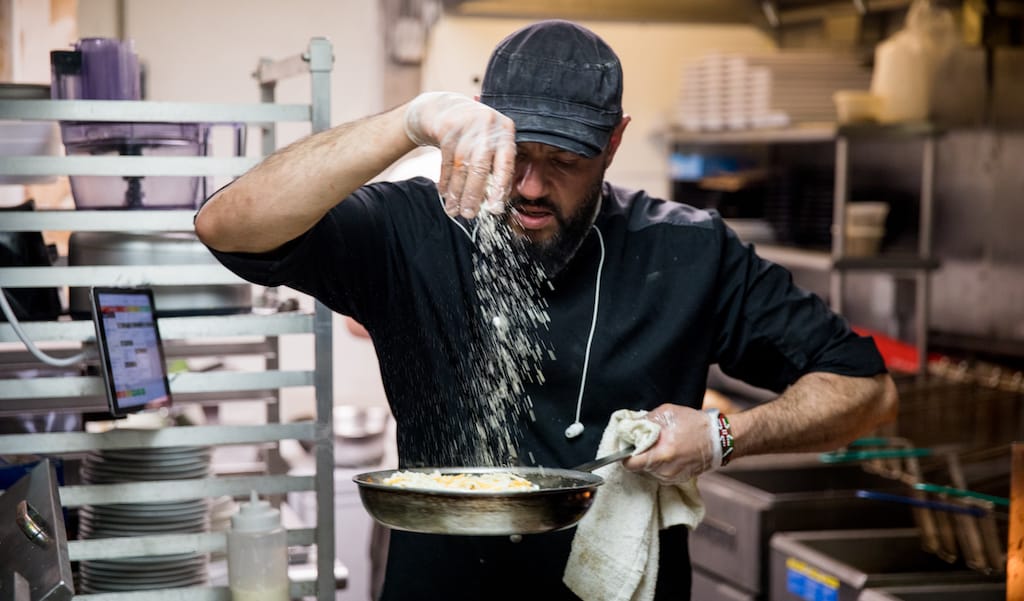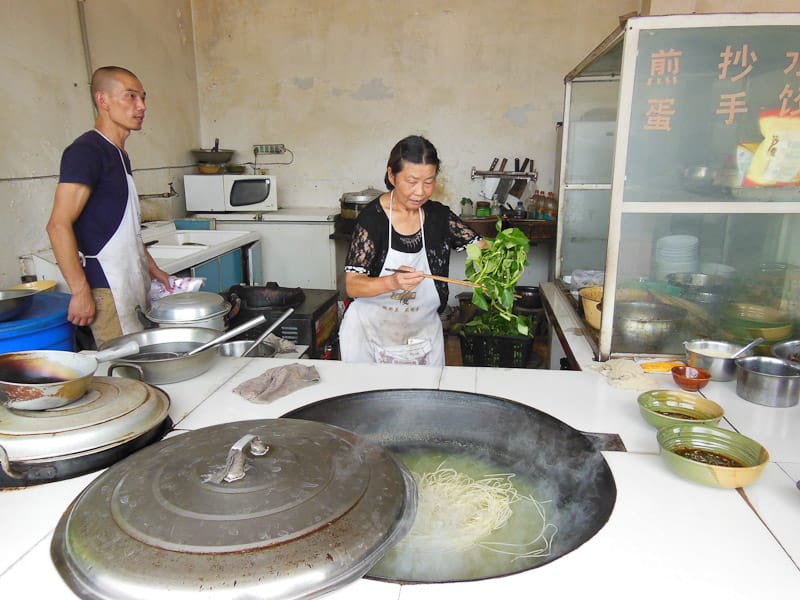Where the A train dead-ends at Lefferts Boulevard, Liberty Avenue stretches on into the heart of the enclave known as Little Guyana, part of the larger Richmond Hill neighborhood. Once a year, for the Hindu holiday of Diwali, a bedazzled motorcade turns the street into an eruption of colors, music and lights that is a taste of home for many of the neighborhood’s Indo-Caribbeans.
Despite this ornate show of community pride, to most Americans, and even New Yorkers, this population remains obscure. “People don’t know who we are,” says Lakshmee Singh, a talk show host and community leader in Queens,Richmond Hill, once a predominantly German and Italian neighborhood, has seen a steady stream of Guyanese immigrants since the 1970s. Today, it’s home to the largest Guyanese community outside of Guyana itself, with Guyanese immigrants representing the second largest foreign-born community in Queens.
But Lakshmee explains that Little Guyana has also become more diverse than it once was: “Today I call it Little Indo-Caribbean.” Trinidadian, Guyanese, and Surinamese businesses all operate side by side along Liberty Avenue. A majority of the area’s population are descendants of “East Indians” from the subcontinent who were brought over to these South American countries by the British as indentured servants to work, mainly on sugar plantations. “I think it’s very important that people know that we’re not East Indian,” she adds. “Maybe generations ago, but we have our own identity now.”
Guyana and its South American and Caribbean neighbors are diverse nations, and their culture is a mixture of South Asian, African, Indigenous, and colonial influences. But at Liberty Avenue’s Diwali parade, everyone comes out to celebrate this Indo-Caribbean tradition. “No one gets paid for the motorcade, but we put a lot of money into it,” Lakshmee explains, “and you know how it happens? Through the support of local businesses.” Little Guyana has a kaleidoscopic array of eateries and specialty shops, but there are a few dependable, affordable and homey establishments that are true anchors for the community.
The crown jewel of Little Guyana is Sybil’s Bakery, which occupies a Flatiron-like triangular building on the eastern end of Liberty Avenue, in the shadow of the AirTrain that runs from Jamaica to JFK Airport. Sybil’s does a brisk business seven days a week, and the full diversity of Guyana is reflected in their staff, clientele and cuisine. Pepper pot, a rich spiced beef stew traditionally served at Christmas, is dished out year round here. One of Guyana’s national dishes, it originated with an Amerindian recipe for stew made with cassareep, a molasses-like sauce made from cassava root. Pepper pot is best eaten with a piece of soft Guyanese plait bread, and Sybil’s makes the best loaf in town.
“We have a lot of items here that I don’t think any other Guyanese outfit in New York has,” owner Viburt Bernard says. “We try to put a lot of love into our work, because we do this for the pride, not necessarily for the money by now.” Viburt, better known by locals as Cookie, opened the Liberty Avenue branch of Sybil’s, which was originally founded by his mother, Sybil Bernard, on nearby Hillside Avenue more than 40 years ago. “When most Guyanese came here,” Viburt says, “Sybil’s was already here.”
Viburt’s office above the bakery is decorated with large photos and paintings of Demerara, Guyana, where the Bernard family has their roots. He still owns a property in the rainforest there, which is only accessible by boat or helicopter. But New York has been his home base since the early 1970s.
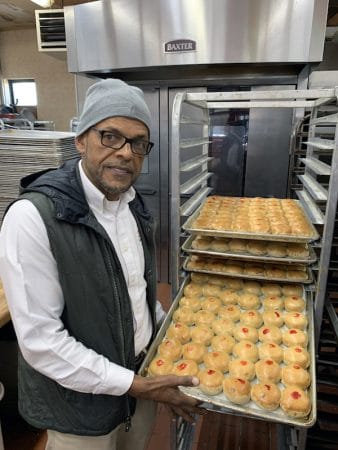
One of nine children, Viburt learned how to bake by working at a family shop back in Guyana. When his mother lost her job in Queens in 1976, she suggested that he pitch in to help start a new business. “So we started baking out of the house,” he explains, “in the kitchen for two years, then we moved to the basement, and then we came out to Hillside Avenue in 1978, and bought a little spot there.”
The Liberty Avenue branch, now something of a flagship, opened 10 years later, and their menu began to expand. “My grandmother was Indian,” Viburt says, “she had a lot of Indian recipes that she gave to my mom, like pholourie[deep fried spicy dough balls] and potato balls. We did those, we did curries of course, and some bakery products like tennis rolls, bread, another cake called salara, a couple pastries, and that was it in the beginning.”
Now Sybil’s serves over a hundred different items, catering to a wider audience. Along with the distinctive, miniature pie-shaped Guyanese beef patty, you can also find the standard-issue Jamaican kind. The diversity of the offerings brings in huge crowds, and Sybil’s is a clear crowd favorite in Little Guyana. “I’ve been doing this for so long now, and it’s not easy work,” Viburt says. “But my mother’s name is on the sign, and we’re proud of that. Sometimes I want to work less, or get out somehow, but we provide jobs to so many people, and provide these products to the community. And I’ve been doing this since I was a child.”
When it comes to other Guyanese and Trinidadian businesses in Little Guyana, Viburt says he wishes them the best, but there are so many that it can be difficult to set yourself apart. Bakeries and roti shops sometimes come and go, and the vast selection of places can be overwhelming. It’s a joy just to stroll down Liberty Avenue and take in the garlands of flowers adorning Hindu goods stores, the smell of curry, and the sounds of Bollywood and Jamaican dancehall music, but Sybil’s isn’t the only local restaurant that’s worth a try. Several other establishments have managed to set themselves apart, too.
A few blocks south on Rockaway Boulevard is Flamingo Restaurant and Mantra Lounge, a somewhat clubbier place specializing in curries, Trinidadian snacks, seafood, and the kind of sweet and spicy Chinese-Caribbean cuisine that’s popular in Guyana and Trinidad. Bake and shark, a flatbread sandwich with chunks of fried shark meat, veggies, and tamarind sauce, is a popular choice. Here the dish is served “Maracas Beach style,” in reference to the beach in Trinidad where bake and shark was popularized, and where the shark is caught just offshore and fried up on the beach. At night Flamingo can feel more like a club, but during the day Lakshmee says, “it’s the only family style Trinidadian restaurant we have in Richmond Hill.”
At Good Hope Restaurant, as at many of the other Guyanese-Chinese establishments on Liberty Avenue, the beer is cheap and the ‘80s soul hits are turned up loud. These bars are modeled off the Chinese restaurants around Guyana, which are generally dimly-lit taverns. Good Hope serves a great rendition of the Sino-Caribbean dish Cha Che Kai Chicken, skin-on chicken chunks fried and tossed with chiles and green onions, producing a distinctly West Indian flavor. It’s best enjoyed with a beer while watching a cricket match or horse race on one of Good Hope’s five flat screens.
Though Good Hope’s funky playlist may be more likely to inspire a beery singalong, the real soundtrack of Little Guyana is chutney music, a Caribbean fusion genre created by the Bhojpuri- and Hindi-speaking diaspora of Guyana, Suriname, and Trinidad. To an outsider, chutney can sound something like Bollywood dance music set to a Jamaican dancehall beat, and though many chutney songs have Hindi lyrics, Lakshmee Singh says most Indo-Caribbean people who sing along don’t actually understand them, having grown up speaking Caribbean English. Even down to its name, though, chutney evokes Guyanese flavor.
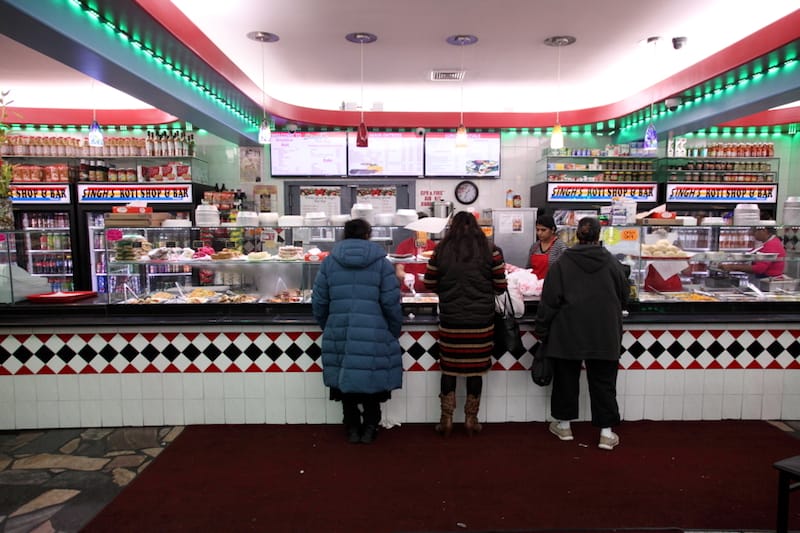
It’s hard to walk down Liberty Avenue without hearing chutney, and at Singh’s Roti Shop & Bar, a DJ spins chutney, soca and reggae while you eat. On Saturday nights, live Caribbean bands play while customers drink at the bar and eat rotis. Singh’s rotis are filled with curried chicken, goat, oxtail, fish or chickpeas, and sit on steam table trays beside chow mein and fried rice. The place dishes out 800 dhalpuris, rotis filled with ground yellow split peas, every single day.
Though their Guyanese clientele is ample, the Singh family is from Trinidad, and they specialize in Trini street snacks like doubles, which have become popular with all Indo-Caribbeans. Doubles consist of curried chickpeas sandwiched between a pair of bara fry breads, optionally topped with various hot pepper and tamarind sauces. Bara indicate the Indian roots of the dish, having descended from the Indian fritters called vada that were brought to the Caribbean by indentured servants. Shivani Singh, whose family owns the shop, says today doubles are a ubiquitous and inexpensive street food on the island. “It’s almost like their version of a hot dog. Everybody eats it. All ethnicities.”
One doubles at Singh’s costs a dollar, and a sign advertises that despite increasing costs, the snack will never cost more than that. “It’s for the community too,” Shivani says. “You want a quick, cheap eat. My parents have been around for 30 years now, and they don’t do a lot of things for the money. They’d rather make people happy.” From its dance hall ambiance to its reliable prices, Singh’s is a community-minded place.
Eat a few Indo-Caribbean meals, and you’ll begin to get familiar with terminology like doubles, bake and shark, and pholourie. But sometimes the flavors can still seem unidentifiable to an outsider. Guyanese and Trinidadian food wouldn’t taste the way it does without ingredients like cassareep, achar (Indian-style pickles), shado beni (an herb known in Spanish as culantro or recao) or gilbacker (a variety of fish now technically banned in the U.S.). Part of what makes Little Guyana so special is that along Liberty Avenue, these specialty ingredients are readily available – even the illicit gilbacker.
Little Guyana Bake Shop offers many of the same baked goods as Sybil’s, but it’s especially notable for its wide selection of groceries. Guyanese brands of tamarind chutney, hot pepper sauce, corned mutton, and crunchy split channa line the shelves. Fresh fish, many of which are specific to Guyanese cuisine, are flown in from the Caribbean every week. Little Guyana Bakery has two locations along Liberty, and it’s only one of many specialty stores offering this kind of Indo-Caribbean variety.
Lakshmee Singh says that in the past, Guyanese would often have to ask relatives to send them items like achar and hot pepper sauce from home, but recently she’s had to tell her family there to stop mailing her Guyanese foods. These days, she says, “anything that you want, you can find on Liberty Avenue.”
 May 17, 2019 Addy’s Barbeque
May 17, 2019 Addy’s Barbeque
We hear it, and smell it, before we see it. At Addy's Barbeque in Astoria, every […] Posted in Queens May 9, 2019 Deej
May 9, 2019 Deej
Hidden in the small, nondescript streets of the Kuştepe neighborhood, just beyond the […] Posted in Istanbul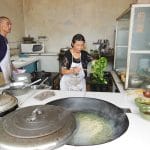 October 1, 2013 CB on the Road: Chengdu’s Spicy Noodles
October 1, 2013 CB on the Road: Chengdu’s Spicy Noodles
It’s been two weeks of cycling through China’s Qinghai province, and the food selection […] Posted in Shanghai
Published on May 06, 2019
Related stories
May 17, 2019
QueensWe hear it, and smell it, before we see it. At Addy's Barbeque in Astoria, every mishkaki enters the dining room with a sizzle. The style of cooking, let's be clear, isn't the "low and slow" barbeque of the American South. Don't expect smoked beef brisket, which requires hours and hours of cooking, and certainly…
May 9, 2019
Istanbul | By Geoffrey Ballinger
IstanbulHidden in the small, nondescript streets of the Kuştepe neighborhood, just beyond the bustle of the Mecidiyeköy metrobus stop and pamphlet-pushing youths desperate to sell you English lessons, sits Дээж or “Deej,” one of the few Mongolian restaurants in Istanbul. We first spotted it from the window of a moving bus while on another residence…
October 1, 2013
ShanghaiIt’s been two weeks of cycling through China’s Qinghai province, and the food selection is slim. The majority of the province sits on the vast Tibetan Plateau, well above the tree line in conditions too harsh for significant cultivation. Yaks graze on well-trampled grass as far as the eye can see, with white yurts and…







































